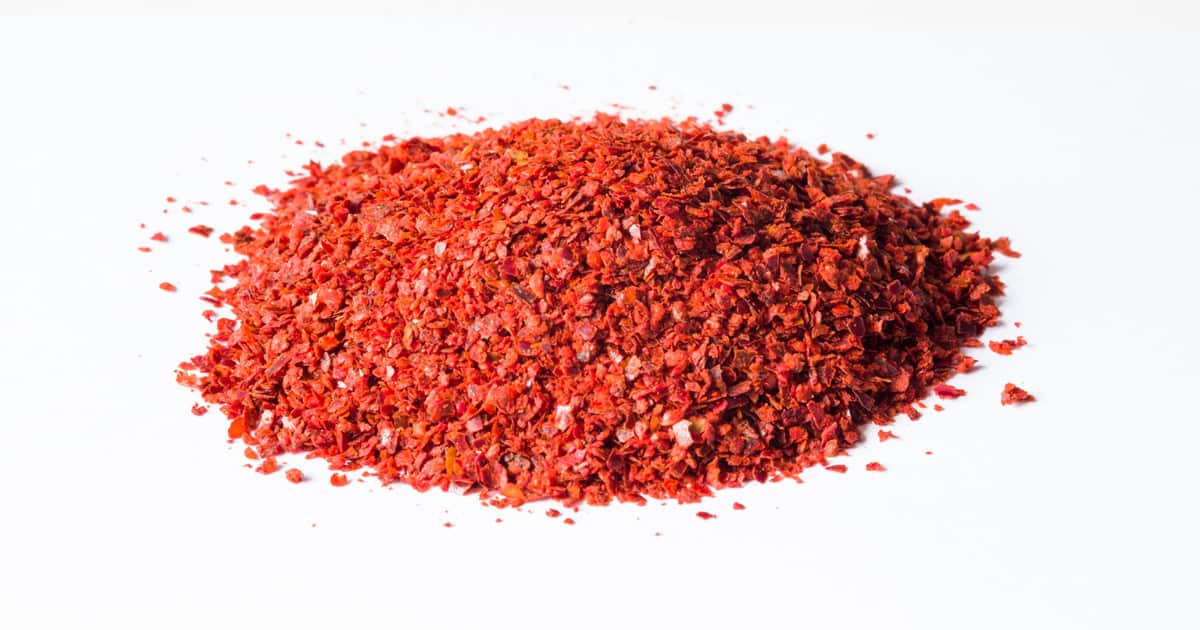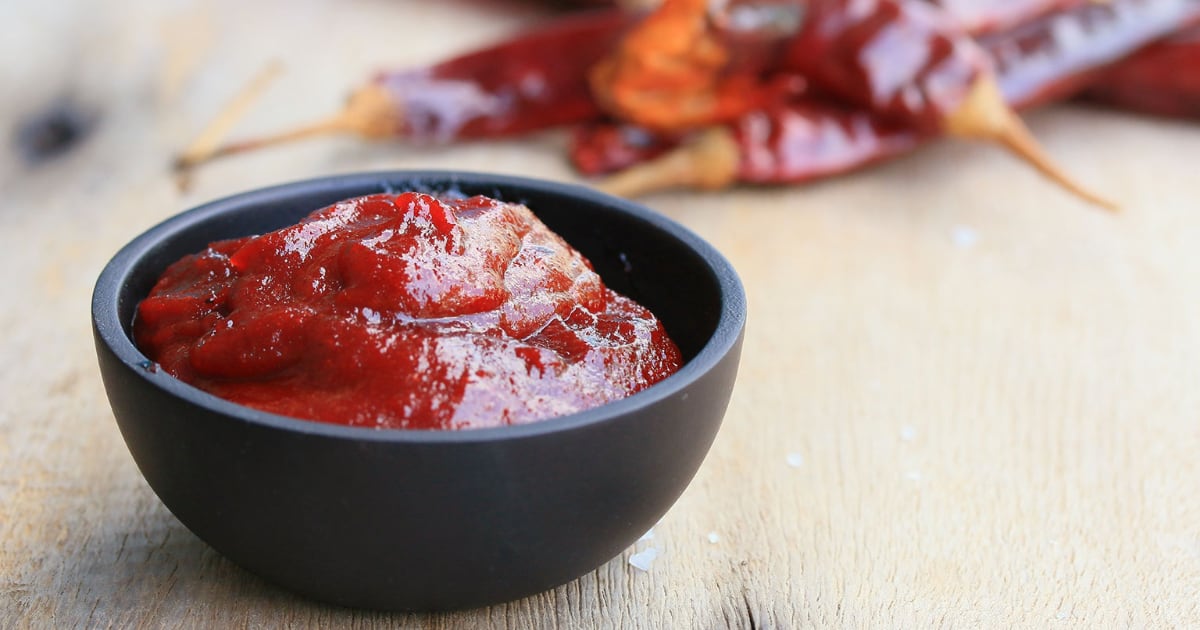Korean cuisine is known for its bold, complex flavors, and two essential ingredients for creating this taste profile are gochugaru and gochujang. While these two staples have some similarities and can be substituted in certain recipes, they are quite distinct in terms of preparation, flavor, texture, and usage.

The key differences between gochugaru, Korean chili pepper flakes, and gochujang, a thick fermented chili paste. We’ll look at how they are produced, their taste profiles, how to use them, and whether they can be swapped.
What is Gochugaru?
Gochugaru is Korean chili pepper flakes or powder. The name translates to “chili pepper powder” in Korean. It is made from Korean red chili peppers called taeyangcho that are dried in the sun, then coarsely ground.
Gochugaru has a vibrant, deep red color and a mildly spicy flavor, sweet and a little smoky. It comes in flake or powder form, with the flakes being more common. The spiciness can range from mild to very hot depending on the amount of seeds included.
In Korean cooking, gochugaru adds a spicy kick and smokiness to dishes like kimchi, stews, soups, marinades, and stir-fries. It's a versatile ingredient that can be used as you would crushed red pepper flakes or other chili powders.
What is Gochujang?

Gochujang is a thick, sticky Korean chili paste. In Korean, “jang” means paste. It has a deep red color and a sweet, spicy, and umami flavor.
To make gochujang, gochugaru is combined with fermented soybean powder, glutinous rice powder, salt, and sometimes sweeteners like honey or sugar. This mixture of ingredients goes through a lengthy fermentation process in large earthenware pots outdoors.
The fermentation, which can take three months to over a year, gives gochujang its characteristic complex flavor - spicy, sweet, salty, and rich. The longer it ferments, the deeper the flavor gets.
Gochujang is used as a condiment, sauce, and marinade in Korean cooking. It's an essential ingredient in dishes like bibimbap, tteokbokki, stews, dipping sauces, and marinades for meats. Just a little bit packs a lot of flavor.
Main Differences Between Gochugaru and Gochujang
While gochugaru and gochujang both contain Korean red chili and bring heat to dishes, there are some key ways that these two ingredients differ:
- Texture: Gochugaru is a dry, coarse powder or flake. Gochujang has a very thick, sticky paste texture.
- Ingredients: Gochugaru is made from just chilis. Gochujang also contains fermented soybean, glutinous rice powder, salt, and sometimes sweeteners.
- Flavor: Gochugaru tastes spicy, slightly sweet, and a little smoky. Gochujang has a more complex flavor - spicy, sweet, salty, and umami from fermentation.
- Heat level: Gochugaru can range from mild to very spicy. Gochujang also varies in spiciness but is generally milder than the hottest gochugaru.
- Preparation: Gochugaru is simply dried and ground chilis. Making gochujang involves a long fermentation process.
- Uses: Gochugaru is versatile and adds heat, color, and flavor to many dishes. Gochujang is more commonly used as a condiment, sauce, or marinade.
Can You Substitute Gochugaru for Gochujang?
While they have some similarities, gochugaru, and gochujang aren't exactly interchangeable. Using gochugaru when a recipe calls for gochujang can work, but a few adjustments will help get closer to the right flavor:
- Add a little miso paste or soy sauce for the fermented flavor.
- For sweetness, add a little sugar, honey, or maple syrup.
- Thin the gochugaru with water, stock, or oil to approximate the paste's texture.
- Start with less gochugaru than the recipe calls for gochujang and adjust from there since it tends to be spicier.
You can also try combining gochugaru with sambal oelek or harissa paste for a closer approximation. Add sweetener and perhaps miso to round out the flavors.
Can You Substitute Gochujang for Gochugaru?
It's easier to substitute gochujang when a recipe calls for gochugaru.
However, here are a few things to keep in mind:
- Gochujang is a paste, so it may not incorporate as well into dry rubs or sprinkle toppings. Mixing it with a bit of oil or soy sauce can help.
- The flavor of gochujang is more complex, so start with about half the amount specified for gochugaru and adjust to taste.
- Gochujang contains salt, so you likely won't need to add as much (if any) extra salt to your dish.
- The paste's sweetness and thickness can change a dish's texture, so consider that.
You can use gochujang instead of gochugaru, but you must make adjustments to get the right spiciness, texture, and flavor balance.
How to Use Gochugaru and Gochujang
Now that you know the differences between these two popular Korean ingredients, here are some tips for using them:
Uses for Gochugaru
- Sprinkle gochugaru on meat, fish, or veggies before grilling or roasting.
- Add it to marinades, dressings, dipping sauces, and salad dressings.
- Use it to make kimchi or add authentic flavor to soups and stews.
- Mix it with sesame oil, soy sauce, honey, or doenjang paste to make spicy dipping sauces.
- Add it to fried rice or noodles for a kick of flavor and heat.
- Combine it with mayo or sour cream as a topping for burgers, tacos, or baked potatoes.
Uses for Gochujang
- Mix gochujang with soy sauce, vinegar, and sugar to make a spicy marinade or glaze for meats.
- Add it to stews, braises, and soups for a deep, savory flavor.
- Use it as a base for dressings and dipping sauces.
- Spread it lightly on a pizza crust before adding toppings.
- Swirl it into pasta sauce, mac, cheese, or mashed potatoes.
- Mix it with mayo or Greek yogurt to make a spicy sandwich spread.
- Add a spoonful of bloody marys or micheladas for a spicy kick.
With their unique flavors and versatility, gochugaru and gochujang are great ingredients to have on hand for spicing up weeknight dinners or taking your Korean cooking to the next level. Start with small amounts, taste, and adjust until you find the perfect balance.
FAQ
What's the difference between gochugaru and regular red pepper flakes?
While they may look similar, gochugaru differs from regular red pepper flakes in a few ways. It has a deeper red color and is less intensely spicy than crushed red pepper. Gochugaru also has a more nuanced flavor - mildly sweet and a little smoky versus just pure heat. The specific Korean chili peppers used give it a unique taste.
Can I make my gochujang at home?
Yes, you can make DIY gochujang at home! You'll need basic ingredients: gochugaru powder, glutinous rice powder, fermented soybean powder, salt, and honey or sugar. Combine the ingredients, transfer to a jar or crock, and let it ferment at room temperature for at least three months, stirring periodically. The longer it ferments, the more complex the flavor will become.
What's a good substitute for gochujang?
Some good gochujang substitutes are miso paste mixed with gochugaru, sambal oelek, harissa chili paste blended with honey and a little rice vinegar, and Chinese doubanjiang chili bean paste. You won't quite replicate the exact taste, but these options can mimic the general flavor profile when you don't have real gochujang.
Can I substitute Aleppo pepper for gochugaru?
Aleppo pepper isn't an exact substitute, but it can work in some dishes where you want mild heat and fruity notes. Since it lacks the subtle sweetness and smokiness of gochugaru, consider adding a small amount of paprika and brown sugar as a sub. Start with about 3/4 of the gochugaru amount specified and adjust to taste.
What's the shelf life of gochujang?
Unopened, commercially made gochujang paste will keep for several months beyond any "best by" date if stored in the refrigerator. Once opened, it's best to use it for peak freshness and flavor within 3-4 months. Properly fermented, homemade gochujang can last up to a year refrigerated. Over time, the paste may thicken, and the flavor will deepen.
Conclusion
As we’ve seen, gochugaru and gochujang have enough similarities to be substituted for one another in some circumstances. However, they are unique ingredients that shouldn’t always be used interchangeably.
Gochugaru is valued for its mild to moderate heat and subtle sweet, smoky flavors. Thanks to its fermentation process, Gochujang packs a more complex punch of sweet, spicy, and umami. Understanding when to use each will help unlock Korean cuisine's bold, satisfying flavors.

